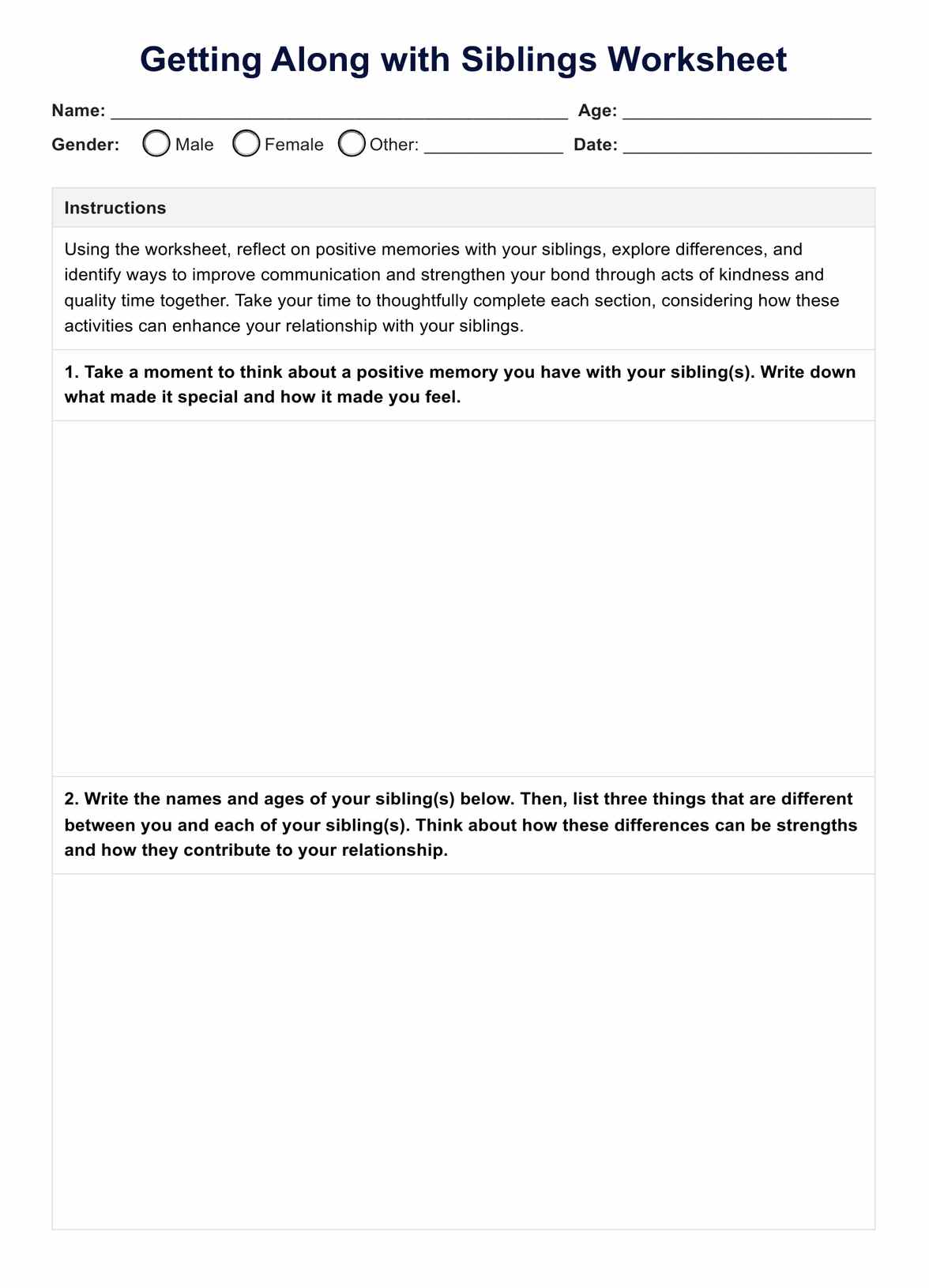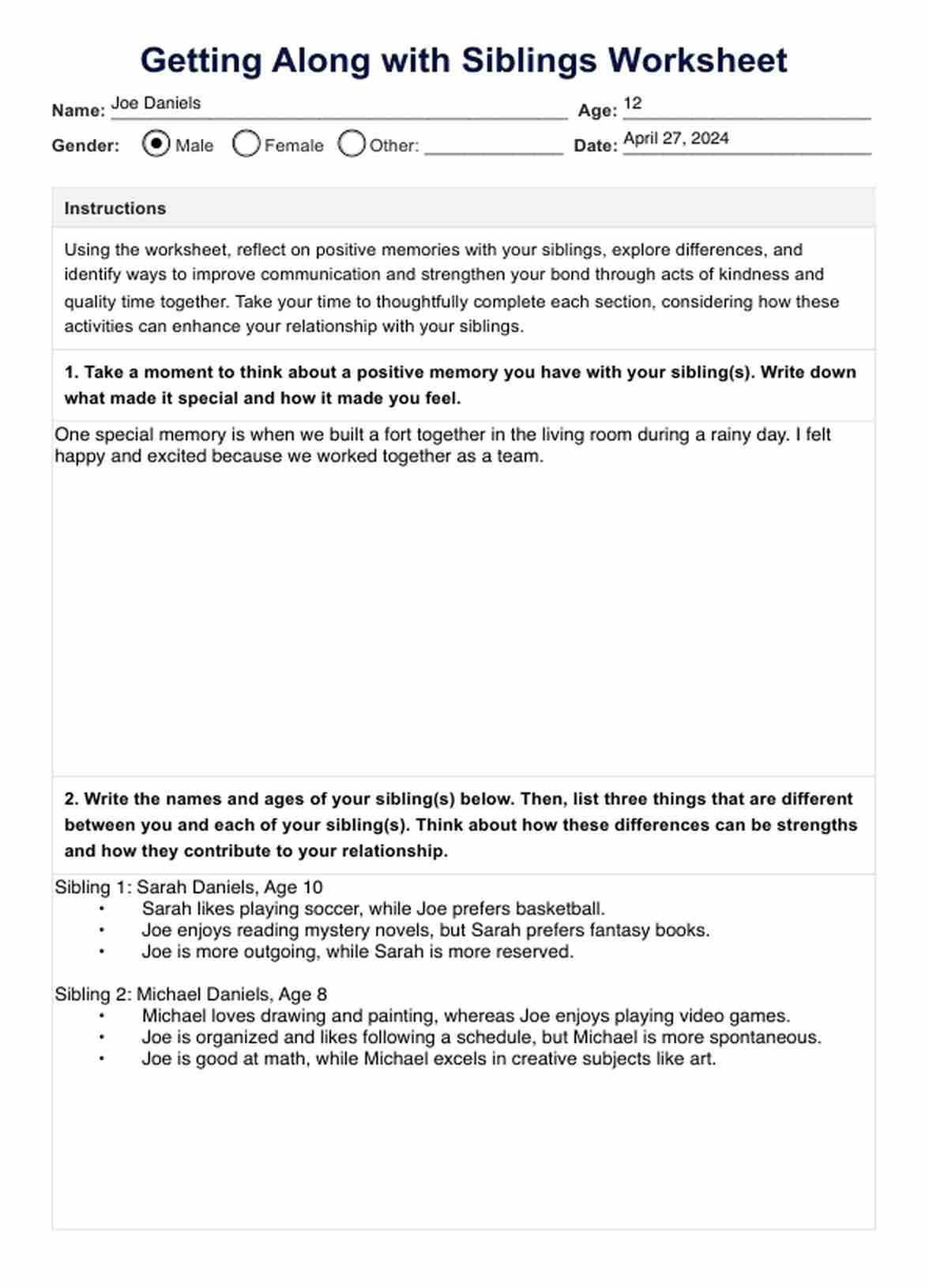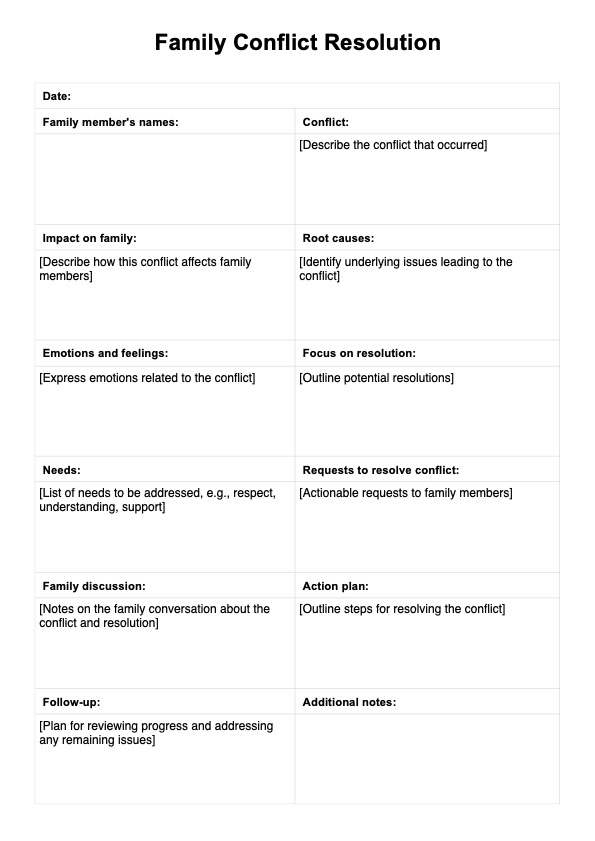Getting Along with Siblings Worksheet
Enhance sibling harmony with the Getting Along with Siblings Worksheet. Download for free today.


Why is it important to make peace with siblings?
Making peace with siblings is crucial for kids and teens as it helps them build strong, supportive relationships that last a lifetime. A brother or sister often becomes a key person in one's life since they can provide a source of love and support.
Getting along with siblings teaches essential life skills like empathy, communication, and conflict resolution. These skills are valuable resources to enhance children's personal development and future relationships. When children and teens feel included and loved by their siblings, it boosts their self-esteem and emotional well-being.
Moreover, a harmonious sibling relationship can provide a stable support system during challenging times. Thus, guiding clients in fostering peaceful and loving connections with their siblings is essential.
Getting Along with Siblings Worksheet Template
Getting Along with Siblings Worksheet Example
Common causes of sibling rivalry
Sibling rivalry may occur as siblings age; for some, it becomes a regular part of their relationship. However, severe sibling rivalry closely resembles emotional maltreatment, negatively affecting psychological well-being, self-esteem, and self-concept, and should be taken seriously (Lupo, 2021).
Here are some common reasons for sibling rivalry:
- Perceived parental favoritism: When one sibling feels their parents favor the other, it can lead to jealousy and competition. This perception, whether accurate or not, can create long-lasting resentment and conflict.
- Individual differences: Each child has a unique personality and temperament, which can clash with their sibling's. Differences in how they handle stress, communicate, and express emotions can lead to misunderstandings and disagreements.
- Limited personal space: Sharing rooms or having little personal space can increase tensions between siblings. Lack of privacy and constant close quarters can lead to frequent arguments and feelings of being overwhelmed.
- Differing interests and hobbies: Siblings with considerably different interests or hobbies may struggle to find common ground. This can result in each feeling misunderstood or undervalued by the other, fueling rivalry and competition.
Knowing what causes sibling rivalry can be the first step to solving issues.
How to use our Getting Along with Siblings Worksheet
Building relationships with siblings is essential for a supportive and loving family dynamic. Through reflection, understanding differences, effective communication, acts of kindness, and quality time together, clients can cultivate deeper connections and resolve conflicts positively. Here are the steps to get you started with helping your clients:
Step 1: Download the worksheet
You can download the provided worksheet template on your device or print it out for your client to use during therapy sessions or for personal reflection at home.
Step 2: Explain the purpose
Explain the worksheet's purpose to your client, emphasizing the importance of building stronger bonds with sibling(s) and how completing the exercises can contribute to this goal. Ask them to personalize it with their information so they will feel a sense of ownership.
Step 3: Reflect
Encourage your client to read the prompts first. Then, ask them to take a moment to recall their positive memories. If they are already adults, consider them to ponder on their childhood experiences. Ask them to write down what made the memory special and how it made them feel.
Step 4: Understand differences
Guide your client in writing their sibling(s) names and ages. Then, ask them to list three different things between them and each sibling. Encourage them to consider how these differences can be strengths and contribute to their relationship.
Step 5: Work on effective communication
Prompt your client to choose a recent disagreement or argument with their sibling(s). Have them write down their feelings during the disagreement and suggest alternative ways it could have been resolved peacefully through effective communication.
Step 6: Do acts of kindness
Motivate your client to brainstorm three small acts of kindness they can do for their sibling(s) during the week. Have them commit to performing at least one act of kindness daily and write them in the worksheet.
Step 7: Spend quality time together
Guide your client in planning a fun activity or outing for the upcoming weekend with their sibling(s). Ask them to write down their chosen activity and why they believe it will strengthen their bond.
Step 8: Review and discuss
At the next therapy session, review the completed worksheet with your client. Discuss any insights gained, progress made, and strategies for further improving their relationships.
Benefits of our Getting Along with Siblings Worksheet
Worksheets can effectively reinforce desired behaviors during therapy sessions. Our Getting Along with Siblings Worksheet can be of benefit in several ways. Here are some of them:
- Promotes emotional intelligence: By reflecting on positive memories and understanding differences, clients learn to recognize and manage their emotions and those of their siblings, fostering more profound empathy and emotional intelligence.
- Enhances conflict resolution skills: The worksheet encourages clients to analyze past disagreements and consider peaceful solutions. It helps them develop effective strategies for resolving conflicts healthily.
- Encourages consistent acts of kindness: Planning and committing to small acts of kindness helps build a habit of generosity and consideration.
- Fosters quality time: The worksheet helps siblings create shared experiences and memories by planning enjoyable activities together. These are crucial for building a strong and supportive relationship.
This worksheet also makes therapy sessions engaging and meaningful.
Reference
Lupo, F. (2021). The shift from normal sibling rivalry to emotional maltreatment and its impact on later psychological well-being. Proquest. https://www.proquest.com/openview/9f2347bd981172726d0788e52326abb7/1?pq-origsite=gscholar&cbl=18750&diss=y
Commonly asked questions
Encourage parents to foster open communication, teach conflict resolution skills, and promote shared activities to help their children understand and appreciate each other.
Suggest addressing the issue early by setting clear boundaries, mediating conflicts calmly, and recommending professional intervention if the rivalry escalates.
Advise parents to encourage mutual respect, support each child's interests, and create opportunities for collaborative and enjoyable activities to strengthen their bond.





















-template.jpg)


















































































